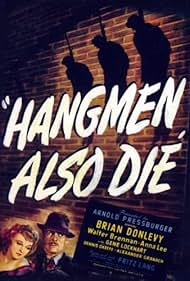The screamer hanging off the end of Hangmen Also Die! kind of says it all. As if “hangmen” and “die” in the same sentence weren’t enough, the title of Fritz Lang’s 1943 film adds extra emphasis, just in case we hadn’t got it.
The scrolling opening prologue continues in much the same vein, informing us that the “thousand year flaming tradition” burning in the hearts of the people of Czechoslovakia was in danger of being extinguished by the Nazis. Czechoslovakia was in fact about 25 years old at the time, having been cobbled together at the end of the First World War (it is now two separate countries again).
This insistence is all a bit unfortunate, because the story here is a good one. And a new one at the time Lang and co-writer Bertolt Brecht went to work on it. So fresh, in fact, that all the details about the assassination of Reinhard Heydrich, the so-called “hangman of Europe” and one of the architects of the Holocaust, were not yet in.
In Lang and Brecht’s retelling (John Wexley also got a screen credit for arcane Writers Guild reasons), we are briefly introduced to Heydrich, an effete brute played by the magnificently named Hans Heinrich von Twardowski, only long enough for us to understand that he’s a monster. He’s soon been murdered off-screen by a member of the Czech resistance, who is almost instantly being pursued through the streets of Prague as he tries to make good his escape.
But Dr Franticek Svoboda strikes lucky. When the Nazi police ask a witness which way the assassin ran, Masha Novotny (Anna Lee) deliberately sends them in the wrong direction. Remembering this later, the doctor on the run tracks down Novotny at her home, which she shares with her father (Walter Brennan), a patriot, and various other family members, some more sympathetic to the Nazis.
From here a case of rinse and repeat, with Dr Svoboda relying on the potentially treacherous family to keep him safe while out in the wider world the Nazis are arresting innocent Czechs in their droves and putting them in front of the firing squad, partly to help flush out the fugitive, partly as a demonstration of their sort of justice.
Should Svoboda turn himself in, and save at least some innocents from death? Or would it be a futile gesture? This is the dilemma Svoboda wrestles with, and in the steely performance of Brian Donlevy we are shown a man who does not know which way to turn.
To add a wrinkle, there is an informer somewhere in the Czech underground, who may flush out Svoboda no matter what he decides.

Lang and Brecht had both fled the Nazis and so knew the background intimately. However, somewhere in the production process the decision was made to Americanise things as much as possible. The fashions and various locales look European, and there are archive shots of Prague for emphasis, but the accents of the various Czechs are all American, presumably to lend an “it can happen here” edge. Listen out for Lionel Stander, as Svoboda’s getaway driver, for the full Bronx hit.
The story has been retold several times, most recently in Anthropoid and The Man with the Iron Heart, both from 2016, with 1964’s Atentát probably the pick of the crop, though all attempts have been dogged by something. After fast and furious directing by Lang early on, and some great lighting by James Wong Howe (how starkly he lights interrogation scenes), eventually the film is dragged almost to a standstill by Brecht’s script, which is verbose and heavy-handed and isn’t happy with a point until it’s been made several times. Anna Lee’s acting, as the woman attracted to the dashingly heroic Svoboda, though she has a perfectly serviceable if questionably patriotic fiancé (Dennis O’Keefe) on the go, is also way over the top, reacting as if receiving an electric shock every time it’s her turn to speak.
Considering it’s to a large extent the same story as Casablanca – the Nazis, a woman between a fugitive and her own man, collaborators, plus various dubious locals – it’s clear it does not have to be this way.
Hangmen Also Die! – Watch it/buy it at Amazon
I am an Amazon affiliate
© Steve Morrissey 2024

